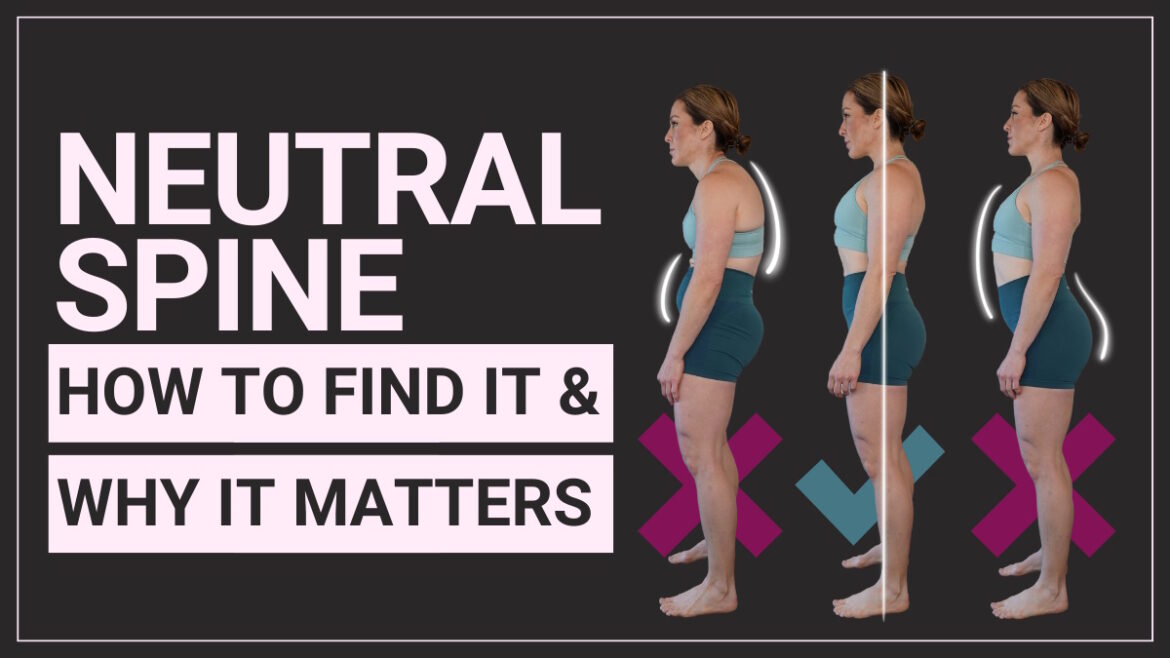You’ve probably heard this about a million times if you’ve ever taken any fitness class: “Find neutral spine.”
If you’ve ever felt confused and had no idea what “neutral spine” means, keep reading to understand how it affects us (especially as moms!).
What is Neutral Spine?
In the most general terms, neutral spine is your aligned, or optimal, position for your body that allows you to properly recruit your core muscles.
Basically, your spine consists of three sections: cervical neck, thoracic middle, and the lumbar. It varies from person to person, but there are natural curves to the spine: a mild s-shape. Having a neutral spine supports these natural curves, allowing for greater support and stability.
Common Posture Mistakes
It is important to note that there isn’t necessarily an “ideal” or one-size-fits-all posture. Optimal alignment is pretty individual.
Generally, due to poor postural and compensatory systems, many people adopt one of two less than ideal spinal and pelvic positions.
- Anterior pelvic tilt is characterized by excessive low-back curve often caused by weak glutes and abs, and overactive hip flexor and hamstrings.
- Posterior tilt presents with the butt tucked under and shoulders hunched. Common imbalances are weak middle back muscles and weak neck flexors, along with tight upper trapezius and pectorals.

Many of these postural imbalances start during pregnancy, as the weight of the bump shifts the center of gravity. These imbalances carry over into postpartum, and can affect your pelvic health even years after having kids.
Neutral Spine is Variable
Keep in mind that while we ought to strive for good posture throughout our day, dynamic and adaptive postures most commonly occur throughout a person’s daily activities, and that’s okay, too.
Today I am addressing spinal neutrality under a load, as in lifting weights–body weight or otherwise. When we are exercising, optimal alignment is essential in helping prevent injury, improve athleticism, and yes, I am going there…recruiting our pelvic floors, too.
Why Is It Important To Find Neutral Spine?
A “neutral spine” is the body’s optimal position to handle stress and heavy loads, something busy moms experience on a daily basis. Even if you’re not in the middle of a workout, it’s important to keep posture in mind.
It is the position in which your spine is most protected and your diaphragm, core, and pelvic floor are most available as a cohesive unit. When we have our spine in “neutral,” it facilitates optimal breathing, circulation, and core muscle firing patterns.
Think of your diaphragm as an upside down bowl and your pelvic floor as a right side up bowl. When our bowls are stacked, they work more optimally. In other words, when your rib cage is stacked over your pelvis, you can better recruit your pelvic floor muscles.
Benefits of a Neutral Spine
There are many benefits to maintaining a neutral spine, especially when lifting a load. Benefits include:
Enhanced Breathing Capacity
When your diaphragm is optimally aligned, you can more properly access a full breath, not just chest (shallow) breathing. This stacked position allows you to breathe down into your ribs and belly. This helps us relax our pelvic floor muscles, and bring them into a state of balance.
Improved breathing has many benefits including:
- Increased metabolism
- Lower stress
- Lower heart rate
- Improved circulation and detoxification
Pregnancy and postpartum changes your body in a major way. Learning how to properly breathe can help you better support your core and pelvic floor, which can have a significant impact on your postpartum healing, stress and anxiety, and constipation issues.
Injury Prevention
You are best able to access your core muscles when you are optimally aligned. The core is meant to protect and stabilize the spine, a vital role in preventing injury.
Reduces Incidences of Dysfunction
Your diaphragm, pelvic floor, and core work together in unison to stabilize your body. Dysfunction within the body may commonly appear in the form of stress, urinary incontinence, diastasis recti, pelvic organ prolapse, low back injury, hip pain, and more. These conditions are often made worse due to poor posture.
Neutral spine is important for everyone, but particularly important for women with pelvic floor issues and/or diastasis recti.
According to a review from Herman Wallace, the authority in pelvic floor physical therapy education, it concluded that patients can generate an optimal amount of pelvic muscle contraction (when strengthening) in a more neutral posture.
Functionality aside, if you are a mama with a lingering pooch, it is easy to see why poor posture may contribute to the appearance of a lower belly pooch.
Finding Your Own Neutral Spine Position
To keep our spine aligned, the diaphragm bowl and pelvic floor bowl need to be stacked.
Here are two drills to help you find your most optimal alignment:
To find neutral spine, keep feet flat on the floor, knees bent slightly, and tilt your pelvis back and forth.
The more you practice finding this ideal position, the more it becomes second nature.
A Strong Neutral Spine To Support Your Day-To-Day
No matter what you’re doing—workouts, laundry, chasing your littles around the house, typing away at a desk—having a neutral spine allows you to move more easily throughout your day because it takes the pressure off your joints and supports long-term health.
Take some time to find neutral spine. Your pelvic floor will thank you.
